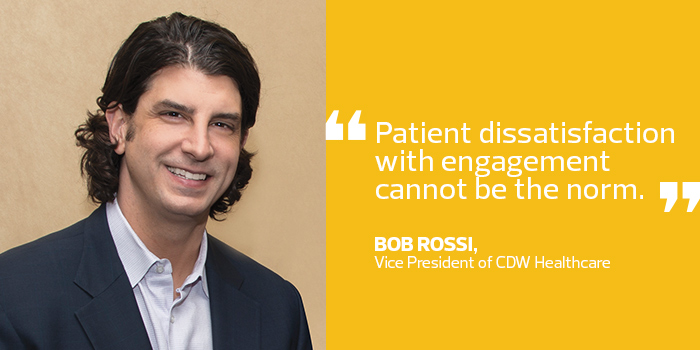Health IT Collaboration Is Key in Reversing Lagging Satisfaction
Now, more than ever, patients turn to technology to take part in their own healthcare.
Ubiquitous smartphone use means increased access to online tools, including health-focused apps and robust patient-facing portals. According to CDW’s "2017 Patient Engagement Perspectives Study," 70 percent of patients have become more engaged in their own healthcare over the past two years — up from 57 percent in 2016.
Additionally, 95 percent of patients have benefited from access to personal healthcare information online, the survey finds.
Despite these trends, providers largely are failing to meet patient expectations around engagement. Nearly 90 percent of patients say they want easier access to their healthcare records. And only 29 percent say they would give their providers an A grade for their use of technology to improve patient-provider communications.
Addressing Erratic Access to Patient Records
A report published in March by the U.S. Government Accountability Office cuts even deeper. It notes that while healthcare provider organizations participating in the 2015 Medicare Electronic Health Record Program offered patients electronic access to their health information, few patients took advantage of that access.
 Patients interviewed by GAO complained of “incomplete and inconsistent” information availability. For many, data was unavailable via their provider’s portal when they needed it; one patient said there was no rhyme or reason to when lab results would post online.
Patients interviewed by GAO complained of “incomplete and inconsistent” information availability. For many, data was unavailable via their provider’s portal when they needed it; one patient said there was no rhyme or reason to when lab results would post online.
Portal functionality, in particular, was a source of dissatisfaction. Setup for patients often proved cumbersome, and many were unaware of download or transmit capabilities within the portals.
The inability to aggregate data into a single, longitudinal health record also aggravated patients, according to GAO.
Patient Engagemen Is a Work in Progress
Many providers realize their shortcomings and are working to move past them.
Engagement is a top priority for more than 70 percent of the providers surveyed by CDW, a figure that’s up from 60 percent last year. Eighty percent say they are trying to ease access to personal healthcare records.
Despite their dissatisfaction, patients are taking notice of the effort. Eighty-three percent say their providers have encouraged them to access their healthcare information, while 81 percent say their providers have offered them the ability to sign up for a patient portal.
Additionally, 35 percent of patients say their providers created a mobile app designed to enable healthcare data access, up from 20 percent in 2016.
One provider-based effort that has gained traction in recent years enables patients to read notes from clinicians posted in their electronic health records through a secure online web portal. To date, health systems across the United States have opened up EHR access to 12 million patients.
More than 77 percent of patients surveyed about the program say it has helped them to better understand their medical conditions, according to statistics presented at HIMSS 2017 in February. What’s more, a majority of patients say the program helps them to feel more prepared for future visits and has enhanced medication adherence.
Other efforts to engage patients focus on creating interactive experiences by boosting on-demand access to online education and entertainment tools that can be delivered across PCs, mobile devices or the bedside TV. At some hospitals, for instance, online platforms allow patients to play video games, stream music or learn more about their care instantaneously.
Feedback Secures Future Success
Ensuring the success of engagement efforts will require feedback and collaboration by multiple stakeholders, from patients to providers and developers.
GAO also wants the Office of the National Coordinator for Health IT to create performance measures to assess efforts related to patient access to longitudinal health data. ONC should then use that information to adjust federal incentive programs that reward patient engagement accordingly, GAO says.
Patient dissatisfaction with engagement cannot be the norm. A focus on patient-friendly tech can help reverse the trend.








